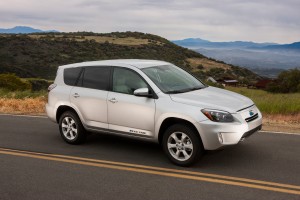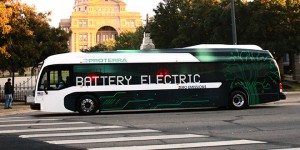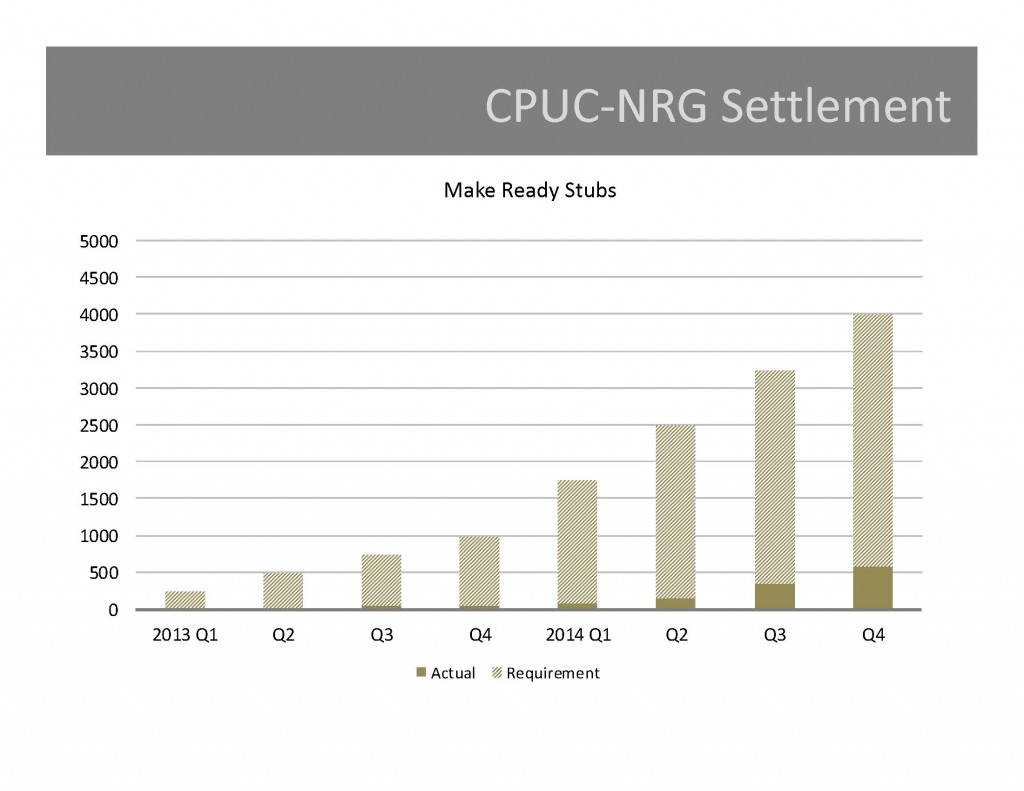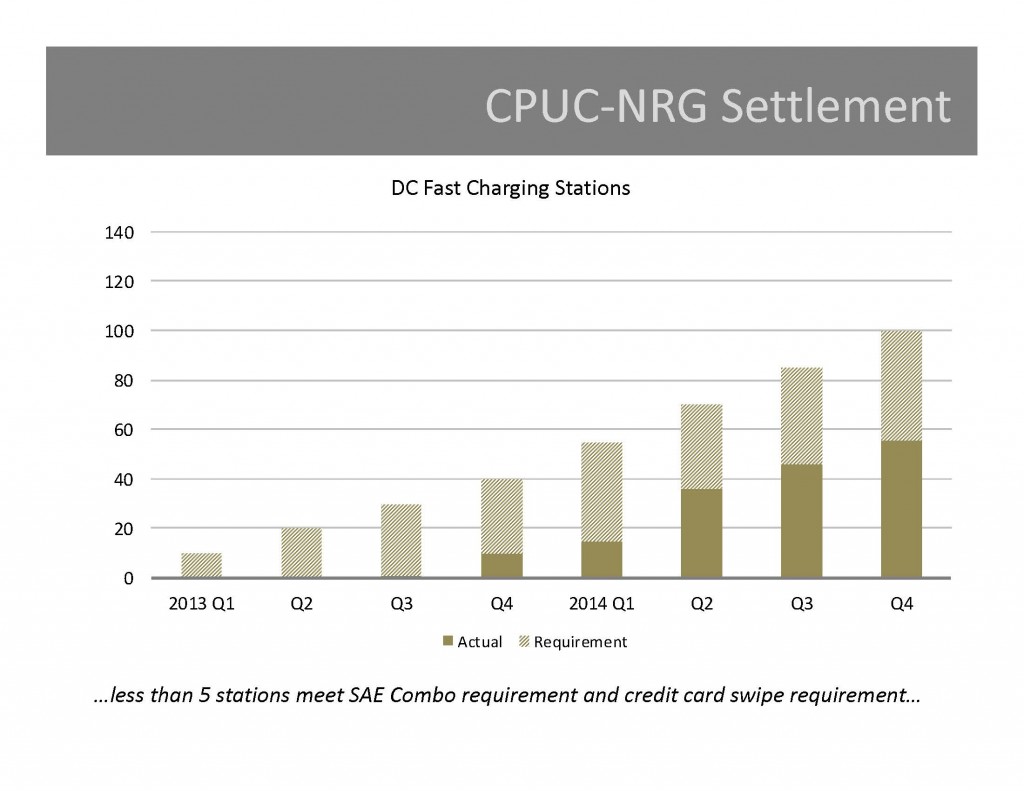 Toyota’s RAV4 electric vehicle is a pretty sweet car, as far as electrified vehicles go. With a range over 100 miles and a Tesla drive train, the car provides a great driving experience at a fairly reasonable price (about $40,000 up front, after state and federal incentives, and of course major fuel and maintenance savings over time).
Toyota’s RAV4 electric vehicle is a pretty sweet car, as far as electrified vehicles go. With a range over 100 miles and a Tesla drive train, the car provides a great driving experience at a fairly reasonable price (about $40,000 up front, after state and federal incentives, and of course major fuel and maintenance savings over time).
But unfortunately Toyota was never committed to the car, producing just 2,600 units over three years, with sales limited to California only and no marketing campaign. I’ve met people from out of state who bought it here to ship to their home states, such was the devotion.
And now the final RAV4 EV has been sold, according to the RAV4 EV message board. The company has no plans to make more, as they are committed to the unfortunate endeavor of making hydrogen fuel cell vehicles instead. I guess they assume they can make more money with the hydrogen technology. Time will tell, but my money is on battery electric vehicles.
But it matters not for the future of this vehicle. Goodnight, sweet RAV4 EV.
I often feel that hard core transit advocates deep down hate electric vehicles. I’ve heard comments to that effect, that EVs are just a shiny new product to justify avoiding building new urban environments and encouraging people to walk, bike, or take transit. Plus, many transit advocates simply hate cars, for the danger they pose to pedestrians and bikers, the physical distance they put between people and divide communities, and the environmental destruction they cause by enabling sprawl and polluting the skies.
 But as someone focused on greenhouse gas reduction, I am a big EV booster. It won’t solve everything, but we need to switch out of petroleum and to bring more investment in battery technologies, which EVs provide. It’s just not realistic to think that everyone can move into an urban, non-automobile environment or that we can entirely retrofit our car-centric built environment in time to avoid climate catastrophe.
But as someone focused on greenhouse gas reduction, I am a big EV booster. It won’t solve everything, but we need to switch out of petroleum and to bring more investment in battery technologies, which EVs provide. It’s just not realistic to think that everyone can move into an urban, non-automobile environment or that we can entirely retrofit our car-centric built environment in time to avoid climate catastrophe.
So for all the EV haters who love transit, maybe they will love Proterra’s new 180-mile range electric bus:
The extended-range Catalyst XR is available in configurations carrying between 129 kWh and 321 kWh of energy storage, and can be recharged in a little over an hour.
“Operating successfully in cities across the country, the Proterra Catalyst is the most energy-efficient transit bus on the market,” said Proterra VP Matt Horton. “Adding extended-range capabilities to our existing portfolio of fast-charge products enables us to help our customers meet more of their most demanding service requirements. The flexibility of our platform allows our customers to more confidently invest in the future of transit.”
Who wouldn’t love a silent, clean and smooth-accelerating bus in their neighborhood? Plus, those batteries could be repurposed for bulk energy storage, while potentially charging at key times when renewable energy is at surplus. And perhaps most importantly, they pay for themselves pretty quickly through saved fuel costs, leaving more transit funds for other purposes.
This could be a kumbaya moment for EV and transit advocates.
Last month I traveled to Portland, Oregon to talk about the possibilities of repurposing used electric vehicle batteries for energy storage across the grid. Drive Oregon, the organization that hosted the event, just posted a recap with speaker slides. Maybe because I’ve heard myself talk on this subject before, I was particularly interested in my co-panelist’s discussion on EV battery recycling:
Steve Sloop, President of OnTo Technologies, presented on the topic of battery recycling and described his organization’s advanced environmentally-friendly technology that extracts valuable materials from EV lithium-ion batteries. He described the rigorous process that he uses to recycle these materials, the results and positive outcomes that he has seen, and the obstacles that he has had to overcome. Steve also pointed out that lead batteries are the cheapest batteries in the world today because they have such a high recycling rate, and that recycled material can actually be cleaner than standard material.
Check out the recap to see my and Steve’s slides. You can learn more about Drive Oregon here.
California is not getting it done when it comes to public charging infrastructure for electric vehicles. The stations are too few and far between, unreliable, and crowded. Brett Hauser, CEO of charging company Greenlots, described the overall problem (for non-Tesla drivers) at a recent California Energy Commission hearing, citing a PlugShare.com survey of EV drivers:
[I]n terms of driver satisfaction or dissatisfaction is the confidence [for EV drivers] in knowing that wherever they’re going, that if they’re trying to plan a trip that is of significant range that there is a great risk that that charge station, when they get there, is either not going to be available or, in fact, will be broken. I think, as a matter of fact, when they surveyed, I think it was about 547 drivers, those drivers that were Tesla drivers, 93 percent of those drivers actually had confidence that that charge station would be up. But all others it was down to 33 percent. Okay, I mean and that’s on all of us.
At the same Energy Commission hearing, many of the major players on EV infrastructure in the state spoke about the lack of progress to date, particularly with respect to publicly funded infrastructure. The transcript is available on-line [PDF].
Perhaps the most striking revelation from the hearing was eVgo’s inability even to come close to meeting the $100 million settlement terms on EV infrastructure spending [PDF] that it agreed to in 2012. NRG, eVgo’s parent company, had reached the terms with the state for the devious corporate behavior of one of its acquired subsidiaries back in the rolling blackout days circa 2000. These charts from the California Public Utilities Commission presentation [PDF] sum up the dismal state of eVgo progress:

It’s gotten so bad that the agency is now hiring an auditor to determine the causes of the non-compliance.
So what gives? NRG/eVgo representative Terry O’Day explained that the siting process for these charging facilities has been extraordinarily complicated. He described it as a multi-step process that typically takes 9-12 months:
And the steps along the way include host approvals for retail tenants and for landlords. It includes utility interconnection. It includes permitting.
He also described some critical gaps in the system, such as in West Los Angeles and San Francisco’s peninsula and East Bay where there’s an “older building stock” that makes siting more difficult. He also noted a big gap in rural Northern California around the faux state of Jefferson. Safety, lighting, and handicap accessibility are all big factors:
You know, we need to plan these stations to consider this edge case of a single mom, with two kids, at 11:00 at night, in rural Northern California, when it’s raining. And that station better work because we took — we convinced that driver to come out to that station in the middle of a rural community. That means it also has to be available.
But even in overcoming these challenges, a larger problem emerges: the lack of a viable business model for private sector ownership of the stations. As Charlie Botsford, project manager for the West Coast Electric Highway, described:
One of our stations took two years to develop. It was on Forest Service property. Don’t ever, whatever you do, put something on government property, especially Forest Service. That was Mt. Hood Ski Resort, so it was really, really difficult. So, I can give you all kinds of horror stories, war stories about siting fast chargers, and getting into lease agreements. A lot of it has to do with why, you know, what’s the motivation for putting a fast charger at a particular site. And, you know, because the business model is — to say that it’s weak is an understatement. It’s even weaker, by the way, for level 2. But for DC fast chargers, it’s a pretty weak business model.
Actually, the best business model that I’ve seen so far is Tesla and they do it for completely different, self-serving reason, purely for the convenience of their drivers. Wow, what an idea.
Complicating matters, the major automakers plan to introduce cheaper 200-mile range, all-battery electric vehicles in the next two years. Drivers’ charging needs are therefore about to rapidly change, as they’ll need more local overnight charging opportunities if they can’t charge at home or work and more interstate-based charging sites between major cities.
So it may be time to rethink how the public supports charging infrastructure in general. Tony Williams, R&D manager for Quick Charge Power LLC, drafted an open proposal to the Energy Commission:
I propose that our state fund a logical California West Coast Electric Highway system comprised of 40 multi-charger (2 minimum) “Plazas” that are powered by onsite batteries, and the batteries are replenished with solar, wind power where applicable, and “single” phase sub-20kW grid power to mitigate or eliminate “demand charges”. These sites would cost approximately $250,000 per site and be placed at 60-100 miles apart along the major corridors that already have freeways:
1) Los Angeles to Sacramento, via 5 and 99
2) Los Angeles to Las Vegas, via 15
3) Los Angeles to Phoenix, via 10
4) Los Angeles to San Francisco via 101
5) San Francisco to Reno via 80
6) San Francisco to Oregon via 101
7) Sacramento to Oregon via 99 and 5
8) San Diego to Yuma via 8These are the logical routes the Californians actually drive to already. With numerous 100-200 mile electric cars on the horizon from major auto manufacturers like General Motors and Nissan, and also premium auto makers like Tesla and Jaguar, these routes must be planned for the near future, but made capable with existing cars that have sub-100 miles ranges. For those cars, I recommend placing small 20kW DC chargers in between each Plaza site, which will not need batteries or infrastructure to eliminate demand charges.
Williams argues that the investment would be relatively small, or “just half the amount of money devoted to hydrogen cars for just one year (just $10 million) by our state,” with an additional $2.5 million to fund 50 additional low powered sites at $50,000 per site.
Of course, this plan won’t necessarily help condo and apartment dwellers who lack home charging options. But that could be addressed in part through new technologies, like chargers on streetlights and chargers that don’t need to be hard-wired but can roam around a parking lot. Plus greater utility involvement in funding urban chargers. Overall, if you combine this interstate charging plaza idea with improved local deployment, then California would be on its way to solving many of the EV infrastructure challenges.
For anyone in the Portland, Oregon area, I’ll be speaking this afternoon about second-life electric vehicle batteries at a Drive Oregon event in downtown. Here’s the blurb from the event organizers:
Created from heavy metals and rare earth elements, the lithium-ion batteries used in today’s electric vehicles are challenging to recycle. However, these batteries and packs are extremely valuable, so the race is on to develop innovative ways to recycle battery cells at the end of their useful lives and provide “second life” applications for these batteries.
Our February event will review the opportunities and challenges in battery recycling and reuse. Our first speaker, Steve Sloop of Bend-based OnTo Technologies, will share the latest developments in battery material recycling and his own company’s unique approach, that is both more effective and less environmentally damaging. Our second speaker, Ethan Elkind of UC – Berkeley School of Law and UCLA School of Law, will discuss current research and pilot projects in the second-use market for battery packs. A lithium-ion battery can retain up to 80% of its original capacity for holding a charge even at the end of its life in a car. Research suggests that discarded batteries aggregated together can serve as inexpensive energy storage for our power grid – a critical component needed to support the integration of more renewable energy sources.
Much of my talk will be based on the UC Berkeley / UCLA Law report “Repurpose and Repower.” You can register to attend here for $25 (non-Drive Oregon members), while Oregon wine, beer and light refreshments will be provided at no additional cost.
Some interesting nuggets from the EV Iron Man. For example, it sounds like the falcon doors on the new all-electric SUV — the Model X — caused the big-time delays on getting the vehicle rolled out:
Getting that right and making sure it works really well and isn’t a gimmick but is a fundamental improvement in utility and aesthetics for the cars, is extremely difficult. There’s a reason other people haven’t done this. And then the second row seats on the Model X are a piece of sculptural beauty. They’re amazing. They’re the nicest second row seats you’ve ever seen in any car, ever. That actually might have been harder than the door. And there are some other things about the X that people don’t know about yet.
Now I’m curious about being a backseat driver in that car. And then Musk discusses the need to hurry up his mass-market EV, the $35,000 Model III that will go 200 miles on a charge but won’t be delivered until 2017 (if we’re lucky):
There are things we could do with the Model III platform that are really adventurous but would put the schedule at risk. So what we’re going to do is have something that’s going to be an amazing car but it won’t be the most adventurous version the Model III to being with. But we will then have the more different version of the Model III, on the Model III platform, following the initial version.
David Baker in the San Francisco Chronicle criticized Musk’s admission here that later models of the III will be better, arguing that it will scare people away from buying the first year’s model. But I disagree. There’s so much pent-up demand for a mass-market EV that Tesla won’t have any difficulty selling this model.
Finally, there’s Tesla’s play to be an energy storage provider: Musk promises to deliver home batteries in about six months, with an unveiling in another month or so.
All in all, lots happening at the company trying to change the world.
I guess the Bay Area didn’t want to be bested by Kansas City. Now Pacific Gas & Electric, Northern California’s primary investor-owned utility (and the state’s largest) wants to get in on EV charging. As David Baker in the San Francisco Chronicle reports:
PG&E on Monday announced plans to install 25,000 electric car chargers across Northern and Central California, in what the company billed as the nation’s largest charger deployment project yet. The utility, based in San Francisco, described the $653.8 million effort as an important step toward reaching Gov. Jerry Brown’s goal of having 1.5 million zero-emission vehicles on the state’s roads by 2025.
So should all ratepayers have to subsidize these installations, even if they don’t drive EVs? Certainly there’s an argument to be made that everyone benefits from cleaner air and a cleaner grid (from EV batteries used as energy storage). And therefore some level of public investment is justifiable. But it seems to me that part of the equation has to be convenient and accurate pricing and payment mechanisms to cover more of these costs. In California, SB 454 (Corbett, 2014) took a step in this direction by requiring open access to charging stations for those who didn’t sign up for a subscription to a particular charging network.
But ultimately, the charging companies will have to figure out a viable business model, such as the gas station revenue from concessions, that minimizes the need for this kind of public investment. In the meantime, and where such a model just doesn’t work, utility money like this will be necessary to transition all of society to cleaner transportation.
I haven’t read her book This Changes Everything: Capitalism vs. The Climate, but I finally caught her interview with Bill Maher back in September (I can’t embed the video but it’s available at that link). I certainly like her focus on climate change and critique of what endless resource exploitation has done to the planet. But I can’t help but feel that climate change for her just presents more evidence in support of her agenda for wholesale economic reform — namely, rolling back capitalism in some undefined way to punish big businesses and allow the rest of us to live more collectively.
And as a result, you get interviews like this one, where she spends over eight minutes talking in vague generalities about the limits of capitalism but not offering any constructive solutions — perhaps other than encouraging Harvard to divest from coal and polluters to pay (for what spending purposes she doesn’t say). Instead, she attacks a “liberal” strawman for claiming that we can solve the environmental problems of our day by simply changing light bulbs and driving hybrids.
As someone who works closely with dedicated policy makers in California and beyond who are quite serious and focused on reducing our greenhouse gas emissions, I don’t recognize her caricature at all. No climate change fighters that I know of would argue that we can reduce our emissions sufficiently just by making easy fixes. Certainly switching to LED light bulbs and driving efficient cars can make an important difference, but we need fundamental changes in our energy system, including massive deployment of renewables, smart grid/demand response technologies, electric vehicles and energy storage, as well as much more housing and jobs located near robust transit systems, with greater energy efficiency throughout our economy.
But maybe Klein doesn’t want to talk about these wholesale, technology-based solutions because they rely very much on our capitalist system. Indeed, California incentives have sparked a competitive, capitalist gold rush to deploy renewables at a rapid scale, as well as electric vehicles and more recently energy storage. We’re trying to do the same for sustainable real estate developers but are limited by local control over land use, which too often are determined by the loudest NIMBYs in any community.
To be sure, California’s program involves some sticks that Klein might like — regulations on the carbon content of fuel, limits (if not de facto bans) on heavy emitters like cement manufacturers, and a cap-and-trade program that adds costs to carbon polluters like fuel providers and other manufacturers.
But ultimately, unless we want to deindustrialize and shiver in the dark, it’s going to take a new, focused capitalism to rescue us from the excesses of the old. And that’s a reality that Klein should acknowledge, unless she has a better plan she wants to unveil.
Yes, you read that right. The city in America’s conservative heartland is about to take the initiative on public charging installations for electric vehicles:
Over the next several months, Kansas City Power & Light (KCP&L) will install more than 1,000 charging sites in the greater Kansas City area. It’s the largest such installation by an electric utility in the U.S. to date, it says.
Called the Clean Charge Network, it will offer free 240-volt Level 2 and DC fast charging to electric-car drivers for the first two years of operations. The network will include 15 fast-charging stations provided by Nissan.
They are reportedly “combination” units that charge that can recharge an electric car using either the CHAdeMO standard (found largely in the Nissan Leaf) and the Combined Charge Standard (CCS) that is supported by all U.S. and German automakers.
The rest of the network will consist of Level 2 stations built and maintained by ChargePoint. All of the charging locations will be part of its national network of charging stations.
I’ve said it before, but it’s about time California let electric utilities take on some of this infrastructure deployment. Private companies, with the exception of Tesla and its Supercharger network, are not getting the job done at a sufficient rate. At least in this one policy area, I hope California takes its cue (or ‘cue?) from Kansas City.
Yesterday’s Superbowl featured two car commercials that couldn’t have been from more opposite ends of the spectrum. The first was from BMW, promoting its new all-electric i3. The spot features Bryant Gumbel and Katie Couric, circa 1994, discussing the internet like they were from a cave. Then they end up in 2015 discussing the all-electric BMW like they still live in a cave — making the point that new, transformative technologies take getting used to at first.
I like the spot because it makes that technology connection to EVs, although I think BMW could have played up the performance of the car rather than focus so much on the wind-powered BMW factory (who hasn’t heard of wind turbines? That’s an old technology). But it’s nice to see all-electrics get Superbowl attention (you may recall the plug-in hybrid Cadillac ELR ran a controversial spot last year). Here’s the BMW ad:
But then Jeep aired an ad for its Renegade SUV that was ultimately galling. Over a pensive rendition of “This Land Is Your Land,” it featured shots of beautiful spots around the world, including Southeast Asian waterways, redwood forests, and North African deserts. At the end, the message is: “The world is a gift. Play responsibly.” And then: “America’s smallest, lightest SUV.”
Only a car company would ask people to celebrate our natural world as a gift while it simultaneously burns the gases that are destroying it. Keep in mind that just 90 companies may ultimately be responsible for two-thirds of the greenhouse gases emitted since the dawning of the industrial age, and the big contributors are oil companies that exist in large part to fuel vehicles like the Renegade.
You can watch the Jeep spot here:




